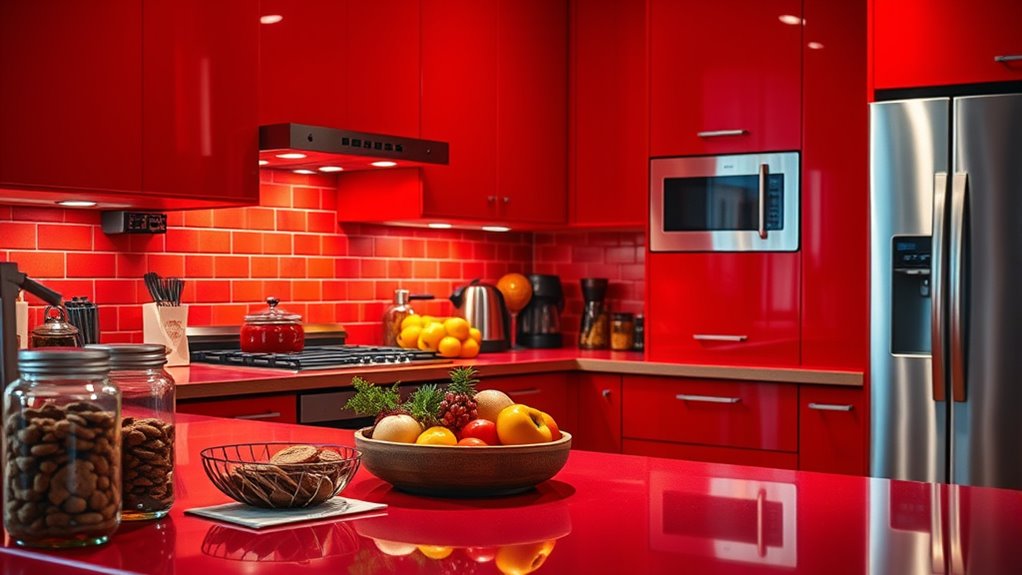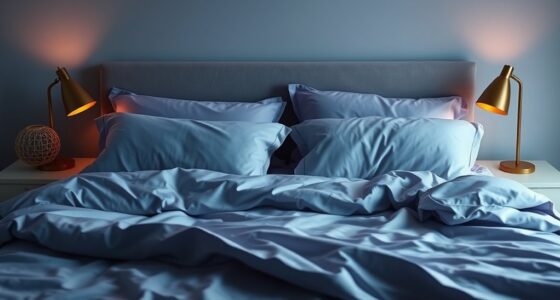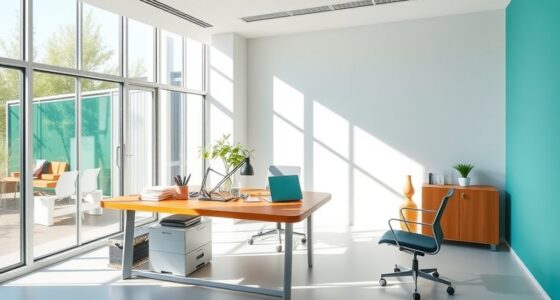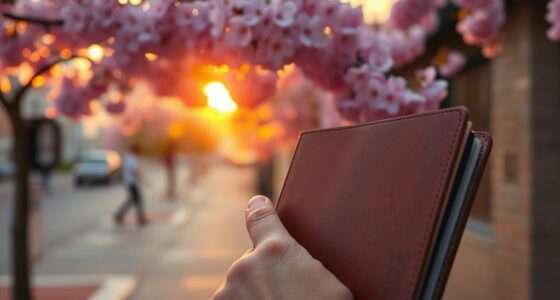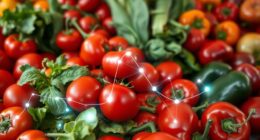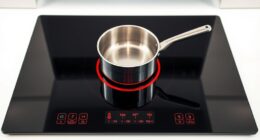A red kitchen can indeed make you eat more by subconsciously stimulating your appetite and increasing your alertness. Scientific studies show warm hues like red boost your heart rate, metabolism, and emotional responses, encouraging larger portions and snacking. This environment may make meals feel more satisfying but can also lead to overeating if you’re not careful. To discover how to control your eating habits in different spaces, keep exploring the science behind color and behavior.
Key Takeaways
- Red stimulates appetite and increases alertness, leading to larger portions and more frequent snacking.
- Scientific studies show red environments can boost metabolism and influence eating behavior subconsciously.
- Red ambient lighting intensifies emotional responses, further encouraging increased food intake.
- The color’s association with excitement and urgency makes meals feel more satisfying and indulgent.
- Being aware of red’s effects allows for environment adjustments to promote healthier eating habits.
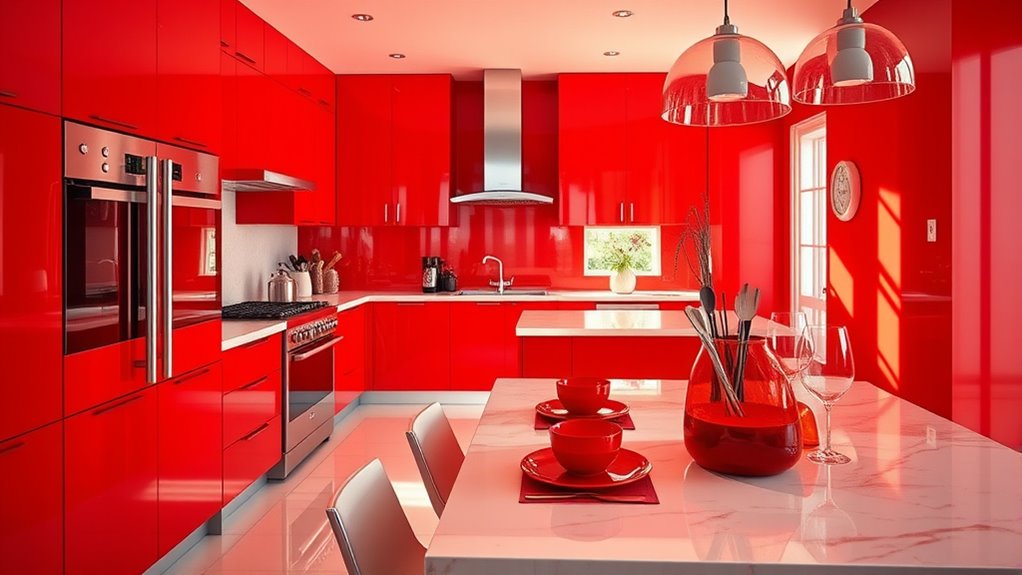
Red kitchens have long been associated with warmth and energy, but they may also influence your eating habits more than you realize. This is where color psychology comes into play. Red, in particular, is known for its ability to stir feelings of excitement, passion, and urgency. When you step into a red kitchen, those emotions can activate in your brain, making you more alert and, in some cases, more hungry. This isn’t just about aesthetics; it’s backed by science showing that colors can directly affect your appetite and eating patterns.
Your brain responds to red on a subconscious level, associating it with stimulation and activity. This connection can prompt your body to prepare for food intake, even if you’re not consciously aware of it. For example, studies have shown that people tend to eat more in environments dominated by warm hues like red. It’s not just about feeling energized—red can also accelerate your heartbeat and increase your metabolism slightly, nudging you toward eating more. The emotional responses evoked by this color can make your meals feel more intense or satisfying, encouraging you to consume larger portions without realizing why. As a result, a red kitchen might make you more prone to snack more or serve larger servings simply because your mind associates the color with hunger and excitement. Additionally, ambient lighting in red kitchens can further enhance these effects by intensifying the color’s impact on mood and appetite.
Understanding this influence through color psychology can help you make more mindful decisions. If you’re trying to control your eating habits, you might want to reconsider the dominant color scheme of your kitchen. Opting for blues or greens—colors linked with calmness and satiety—can help you feel more relaxed and less driven to eat impulsively. Conversely, if you’re hosting a lively dinner or celebration, a red kitchen could enhance the energy and encourage everyone to indulge a little more. Recognizing the emotional responses triggered by red allows you to harness its power intentionally, either to boost your appetite or to create a specific atmosphere.
In essence, the color of your kitchen isn’t just a matter of style; it’s a subtle but potent factor that influences your eating habits through emotional responses rooted in color psychology. Being aware of this connection gives you the opportunity to shape your environment in ways that support your health goals or enhance your social gatherings. Whether you want to eat less or indulge more, understanding the science behind red’s influence can help you take control of your habits more effectively.
Frequently Asked Questions
Do Red Kitchens Influence Eating Habits Across Different Cultures?
You might wonder if red kitchens influence eating habits across cultures. Cultural perceptions and design aesthetics vary widely, so red’s impact isn’t universal. In some cultures, red symbolizes luck and energy, encouraging social eating, while in others, it’s linked to warning signs or danger. Your environment’s color can shape your mood and appetite, but cultural context determines how powerful that influence truly is across different societies.
Can Red Decor Impact Appetite Differently in Children Versus Adults?
Imagine a red kitchen flashing its bold hue; it stirs different emotions in children and adults. Color psychology reveals that red can boost appetite, but emotional responses vary with age. Children might feel energized and enthusiastic to eat, while adults could experience heightened excitement or even anxiety. So, yes, red decor impacts appetite differently, tapping into emotional responses shaped by age and experience.
Are There Health Risks Associated With Red-Colored Kitchens?
You might wonder if red kitchens pose health risks. While vibrant red can boost appetite, it doesn’t directly threaten your health, but it could influence kitchen hygiene habits—making you less mindful or more hurried. Also, prolonged exposure may cause color fatigue, reducing your appreciation for the space. Stay attentive to maintaining good hygiene practices and consider balancing red with neutral tones to prevent visual fatigue.
How Does Lighting Interact With Red Walls to Affect Eating Behavior?
Lighting psychology plays a key role in how you perceive wall colors like red. When red walls are paired with warm, bright lighting, it can intensify the color perception, stimulating appetite and encouraging you to eat more. Conversely, dim or cool lighting softens the red’s impact, potentially reducing your desire to snack. So, your kitchen’s lighting choices directly influence how red walls affect your eating behavior.
Does the Size of a Red Kitchen Alter Its Impact on Appetite?
In your kitchen design, the size of a red space influences its effect on appetite, according to color psychology. A smaller red kitchen might intensify feelings of hunger, while a larger one could create a more balanced environment. You should consider how the room’s proportions interact with bold red walls, as this combination can either stimulate or relax your appetite. Adjusting size and color together helps control your eating habits effectively.
Conclusion
So, next time you’re designing your kitchen, remember that choosing red isn’t just about style—it could influence how much you eat. Imagine walking into a room that feels like a fiery feast, tempting you to indulge more. Studies show red kitchens can make you eat up to 25% more. Just like a siren’s call, that bold color might lure you into finishing your plate before you even realize it. Choose wisely!
